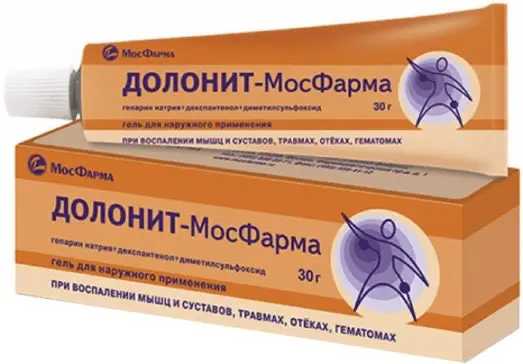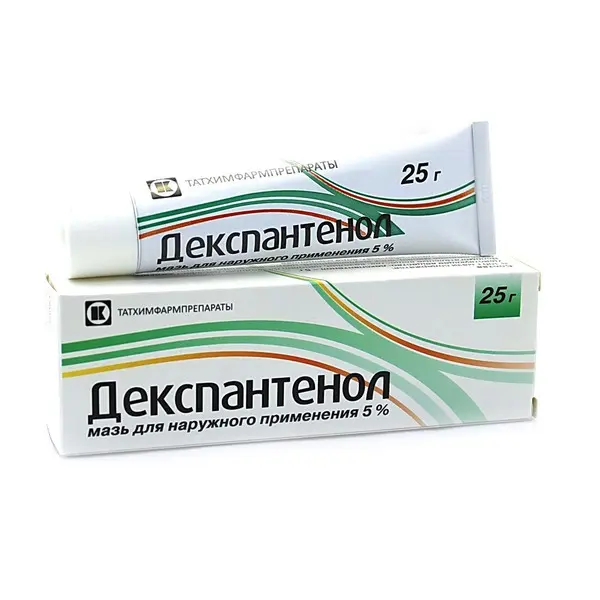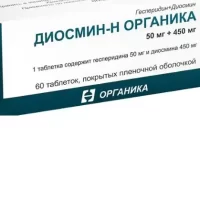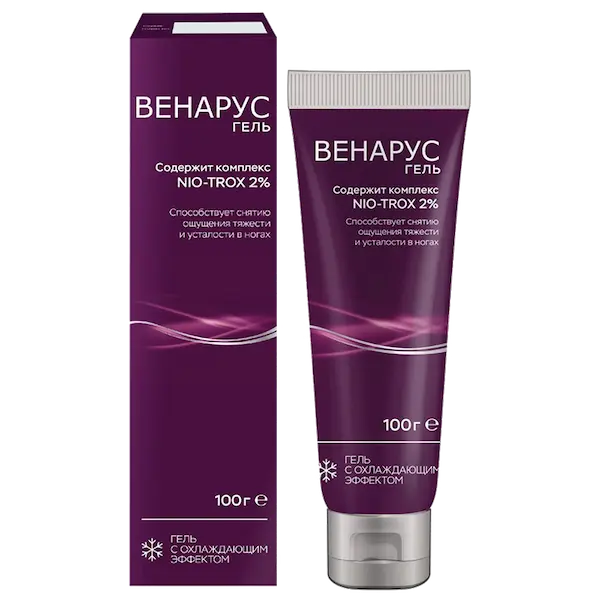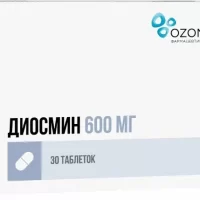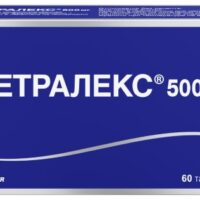Description
Dolonit-MosPharma Pharmacodynamics
The action of the drug is caused by its constituent active ingredients: dimethyl sulfoxide, heparin sodium and dexpanthenol.
Dimethylsulfoxide (DMSO).
Dimethylsulfoxide has anti-inflammatory, anti-exudative and local anesthetic effects. It penetrates through biological membranes, including the skin, contributing to better and deeper penetration into the tissues of other drugs used simultaneously with it.
Anti-inflammatory activity is associated with several pharmacological effects, the most important of which is inactivation of hydroxyl radicals that are produced in large quantities during inflammation and have a damaging effect on tissues.
DMSO has a local analgesic effect due to reduction of conduction speed of nociceptive (pain) impulses in peripheral neurons.
Anti-edema effect is provided by inactivation of hydroxyl radicals and improvement of subcutaneous metabolic reaction in the place of application of the drug. To a certain extent, hygroscopic properties of DMSO are also responsible for its anti-edematous effect.
DMSO (50% and more) penetrates through biological membranes, including skin, contributing to better and deeper penetration into tissues of other drugs used simultaneously.
Sodium heparin.
Sodium heparin, which is part of the drug, is a direct-acting anticoagulant; due to inactivation of biogenic amines in the tissue it shows a clear anti-inflammatory effect, improves local blood circulation. Sodium heparin inhibits the action of hyaluronidase and thus effectively promotes regeneration of connective tissue.
Sodium heparin shows dose-dependent antithrombotic effect, increasing inhibitory activity of antithrombin III on prothrombin and thrombin activation. Penetration of sodium heparin through healthy skin is dose-dependent and confirmed for doses starting at 300 IU/g.
Dexpanthenol.
Dexpanthenol exhibits anti-inflammatory and dermatoprotective effects and stimulates regeneration processes. After absorption, it is converted into pantothenic acid, which is involved in numerous metabolic processes as a part of coenzyme A; by improving the processes of granulation and epithelialization, it promotes regeneration of damaged skin.
Indications
– Swelling, bruising and inflammation of soft tissues, muscles, tendons, tendon sheaths and ligaments after contusions, squeezes, injuries;
– closed injuries, contusions;
– injuries of joints with damage to ligaments;
– periarthritis and epicondylitis of the shoulder (“tennis player’s elbow”), tendinitis (tendon inflammation), tendovaginitis (tendon sheath inflammation), bursitis (inflammation of mucous membrane of joints); osteoarthritis (if periarticular tissues are affected);
– acute neuralgia.
Contraindications
– Hypersensitivity to one of the gel components (active/supplementary substances);
– Severe liver and/or kidney dysfunction;
– bronchial asthma;
– Severe cardiovascular system disorders (functional class IV angina by the classification of the Canadian Society of Cardiology, myocardial infarction, stroke, marked generalized atherosclerosis);
– Pregnancy, breast-feeding;
– Children under 5 years of age.
Do not apply the drug to the mucous membranes (eyes, nose, mouth), open wounds or damaged skin (e.g., condition after irradiation or severe sunburns, fresh postoperative scars).
Administration during pregnancy and breastfeeding
Administration during pregnancy
Because of the lack of data on the application of the drug in pregnant women, its use during pregnancy is contraindicated.
Administration during breastfeeding
Dimethylsulfoxide penetrates into breast milk, therefore during administration of the drug it is necessary to stop breast-feeding.
Directions for use and dosages
- Apply a thin, superficial layer of the drug to the affected area or the skin over the painful area (swelling, edema, inflammation) and spread evenly with gentle rubbing motions, taking care to avoid applying the gel directly to wounds and abrasions.
- In order to cover the entire surface of the bruised knee is usually enough to squeeze out of the tube 3-4 cm of gel.
- The procedure is repeated 2-4 times a day for 7-10 days or until symptoms such as pain, swelling, edema and inflammation disappear.
- If within 10 days of treatment there is no clear improvement, you should consult a doctor.
When applying dressings with gel, a breathable dressing is applied only after most of the gel has penetrated the skin and the alcohol has evaporated (a few minutes). - Dolonite and ionophoresis. This drug can be used in ionophoresis. Sodium heparin contained in the drug is an anion in solution. Application of the drug under the cathode promotes increased penetration of sodium heparin into the affected area, and dimethyl sulfoxide has a synergistic effect with the effect of the electric current (pain relief, reduction of local edema).
- Precautions. It must be remembered that the very treatment with electric current can cause local skin irritation reactions. Therefore, it is necessary to carefully follow the instructions of the manufacturers of the devices, so that the use of the drug does not intensify these local reactions.
- Attention should always be paid to the sufficiency of covering the electrodes with a damp sponge.
- Dolonite and ultrasound (phonophoresis). This preparation is a good contact gel for ultrasound therapy (phonophoresis). The active ingredients in the gel (dimethyl sulfoxide and sodium heparin) supplement the therapeutic effect of ultrasound waves.

